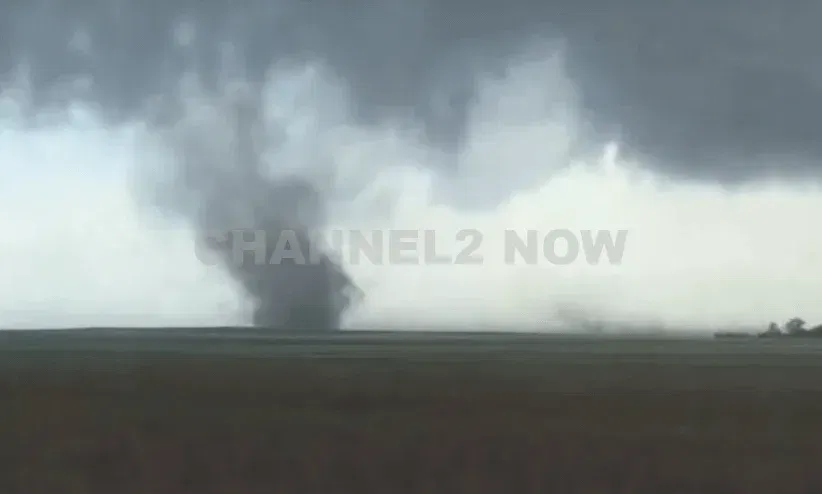On the evening of Friday, under the cloud-laden skies of northeastern Colorado, a confirmed tornado tore across the rural terrain near Willard, Merino, and several other vulnerable communities. This event, tracked and verified by weather spotters, was more than a meteorological anomaly; it was a stark reminder of the raw power of nature and the vital importance of preparedness in a region frequently tested by severe spring storms. According to the National Weather Service (NWS) in Denver, the tornado touched down near Merino in southwestern Logan County at approximately 5:11 p.m. MDT and moved southeast at a pace of 20 miles per hour. The warning issued for southwestern Logan County and north-central Washington County was set to remain in effect until 5:45 p.m., but its ramifications—both physical and emotional—will extend well beyond that brief thirty-four-minute window.
The confirmed sighting of the tornado, distinct from a radar-indicated signature, elevated the urgency of the situation. Trained weather spotters observing the rotating funnel provided real-time verification that a tornado was on the ground, which significantly enhances the credibility and severity of a warning. These ground confirmations often mean the difference between passive watchfulness and immediate life-saving action. As the tornado advanced southeastward across Logan and Washington counties, its potential to inflict serious structural damage, uproot trees, tear down power lines, and obliterate mobile homes became a pressing reality for residents.
Communities identified directly in the tornado’s projected path included Merino, Prewitt Reservoir, Atwood, Logan Corners, Willard, and Messex. Each of these locations, largely characterized by rural housing, agricultural infrastructure, and mobile homes, represents an area with heightened vulnerability in the face of such atmospheric aggression. The very layout and construction of homes in these regions underscore a broader truth: rural America, while spacious and scenic, often faces acute risk from tornadic activity due to limited access to reinforced shelters and emergency services.
The timing of the tornado’s appearance—just after 5:00 p.m.—coincided with a transitional period for many residents: children arriving home from school, workers beginning to return from their jobs, families settling into evening routines. These factors complicate evacuation and sheltering procedures. When seconds matter, the ordinary rhythms of daily life can become liabilities, especially when residents are caught off guard or rely solely on delayed alerts from broadcast news rather than real-time digital notifications from NOAA weather radios or mobile alert systems.
The National Weather Service’s guidance during this emergency was unequivocal and urgent. Residents were advised to seek shelter immediately in basements or interior rooms on the lowest floors of sturdy buildings. The importance of such sheltering cannot be overstated. Tornadoes generate intense wind speeds—often exceeding 100 miles per hour—that can turn even mundane objects into lethal projectiles. Flying debris presents a significant risk of injury or death, particularly for those caught outdoors or in vehicles. Moreover, structural integrity is compromised when roofs are lifted, windows are shattered, and walls are punctured. The destruction of mobile homes, frequently referenced in tornado warnings, is not hypothetical; historical patterns show that these structures are often reduced to splinters during direct hits.
The behavioral instructions offered by NWS also addressed a common but dangerous impulse: attempting to flee a tornado by vehicle. Given the erratic movement patterns of these systems and the limited road networks in rural counties, such efforts often prove fatal. Instead, residents without access to shelter were advised to lie flat in low-lying areas, covering their heads and necks to protect against flying debris. These recommendations reflect long-standing best practices developed by meteorologists and emergency management experts through decades of studying tornado fatalities and injuries.
To understand the gravity of this event, it is essential to situate it within the larger climatological and historical context of tornado activity in Colorado. While not typically associated with the so-called “Tornado Alley” of Texas, Oklahoma, and Kansas, Colorado does experience a substantial number of tornadoes each year, especially during the spring and early summer. In fact, the eastern plains of Colorado—where Logan and Washington counties are located—are particularly susceptible due to the interaction of moist Gulf air with drier air masses descending from the Rocky Mountains. This volatile mixture fosters the supercell thunderstorms that give rise to tornadoes.
The community of Merino, situated just southwest of Sterling, has experienced severe weather in past decades, but the confirmation of a tornado directly on the ground marks a critical moment in its recent history. Similarly, the Prewitt Reservoir area, known for its recreational uses and rural cottages, faces unique challenges during such weather events, as its sparse infrastructure limits the availability of reinforced shelters. Atwood, Logan Corners, Willard, and Messex—small agricultural towns with limited emergency facilities—are all emblematic of the vulnerability faced by dispersed communities where communication, transportation, and medical infrastructure can be quickly overwhelmed.
This tornado warning also serves as a stress test for local emergency preparedness systems. How quickly could warning sirens be activated? Were emergency broadcasts effective in reaching every household? Did schools, nursing homes, and businesses execute their severe weather protocols with efficiency? The answers to these questions will shape not only the community’s recovery but also its resilience against future storms. Public safety officials in northeastern Colorado will likely conduct post-incident assessments to evaluate response times, shelter availability, and the effectiveness of public communications. The outcome of such evaluations may lead to investments in additional warning systems, the construction of community storm shelters, and enhanced weather education for residents.
The psychological impact of such events, while less visible than downed power lines or shattered windows, is no less real. The confirmation of a tornado on the ground can trigger profound anxiety, especially for residents who have experienced previous weather-related trauma. Families forced to huddle in basements or storm shelters, unsure whether their homes will still be standing after the winds pass, face emotional tolls that linger well beyond the physical storm. For children, the experience can be formative and distressing, shaping their perception of safety and community stability.
Local emergency services, including volunteer fire departments and sheriff’s offices, were likely mobilized to support storm tracking, public safety, and post-tornado reconnaissance. Their work—often underpaid and underrecognized—is crucial in securing disaster scenes, aiding in search and rescue efforts, and relaying critical information back to regional emergency coordination centers. Their ability to rapidly assess damage and communicate needs to state or federal authorities can influence whether communities receive timely aid and how quickly utilities are restored.
Furthermore, the agricultural implications of this tornado cannot be dismissed. Northeastern Colorado is a hub for farming and livestock, with fields of wheat, corn, and barley stretching across the plains, interspersed with cattle ranches. A tornado carving through such territory can devastate entire harvests in minutes, flattening crops, killing livestock, and destroying equipment and storage facilities. For family-run farms, the damage can be financially crippling. Insurance may cover some losses, but the disruption to planting or harvesting schedules has cascading economic consequences.
Utility companies servicing the region are also placed under immense pressure during such storms. Downed power lines and disabled substations create dangerous working conditions for linemen tasked with restoring service. Given the rural layout of Logan and Washington counties, crews often must traverse long distances over difficult terrain to reach affected areas. Power restoration timelines can stretch into days, particularly if roads are blocked by debris or flooding—a secondary concern that often follows torrential rains accompanying tornado-producing supercells.
As updates continue to emerge from this unfolding event, the role of local and state meteorological institutions becomes even more critical. The NWS in Denver, responsible for issuing the initial warning, must now coordinate with storm spotters, emergency responders, and the public to provide ongoing assessments. Their analysis of radar data, wind shear profiles, and atmospheric pressure readings will determine whether additional tornadoes may form in the area or whether the system has weakened sufficiently to pose no further threat.
In the aftermath of such tornado events, the importance of community cohesion and resilience becomes paramount. Religious institutions, schools, and civic organizations often step into the void, providing shelter, food, and emotional support. Fundraisers and donation drives frequently emerge as lifelines for families who have lost homes or possessions. The strength of small-town America is often measured in these moments—not by the absence of disaster, but by the collective resolve to rebuild, to care for one another, and to confront future storms with hardened experience.
This tornado near Willard and its surrounding communities is not simply a weather event; it is a narrative of vulnerability, urgency, and the unrelenting tension between human settlement and the natural world. It underscores the necessity of constant vigilance, scientific investment, and community preparedness in an era of increasingly unpredictable climate events.
As the skies clear and emergency sirens fall silent, the work is only beginning. Damage must be assessed, lives must be accounted for, and futures must be recalibrated. The NWS has encouraged all residents who witnessed the tornado or captured video footage to report their observations. These accounts are invaluable—not just for public record but for meteorologists striving to refine predictive models and improve future warnings.
For the communities of Merino, Prewitt Reservoir, Atwood, Logan Corners, Willard, and Messex, this tornado will not soon be forgotten. Whether they experienced its wrath directly or narrowly escaped its path, they are now bound by a shared episode in their local history—one that will shape how they prepare, how they respond, and how they remember.


Leave a Reply